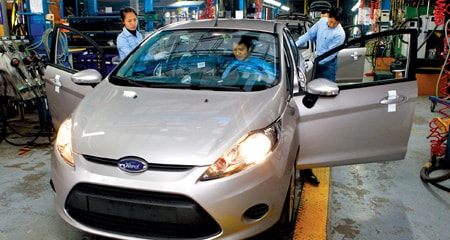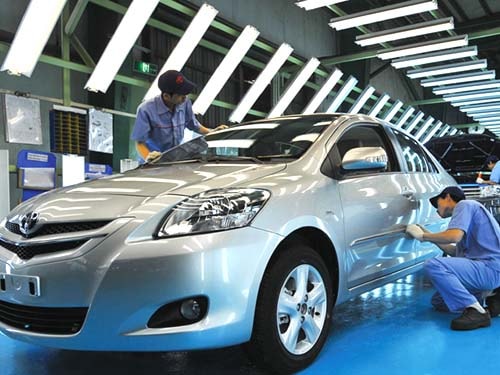High tax collection decision crushes the dream of cheap cars
High taxes are the main reason why car prices in Vietnam are 300 million VND higher than in other countries in the region, especially the special consumption tax applied to cars with less than 9 seats.
This is the comment of the Institute for Industrial Policy and Strategy Research (Ministry of Industry and Trade) at the recent conference summarizing 10 years of implementing the development strategy of Vietnam's mechanical industry.
Currently, private cars with 9 seats or less are subject to special consumption tax of 45-60% depending on the cylinder capacity. Furthermore, this type of car is taxed after calculating the purchase price of the component set plus import tax, causing the car price to increase and is the reason for the narrowing of the market size and low output.
Enterprises demand increased incentives
Recently, the Vietnam Automobile Manufacturers Association (VAMA), when contributing opinions to the draft "Automotive Industry Development Strategy for the period 2020 with a vision to 2030", proposed a 20-25% reduction in special consumption tax on all types of vehicles with 9 seats or less, starting from 2014, with the aim of helping to reduce car prices, creating conditions to increase market size to accelerate localization.
 |
| Reducing special consumption tax will help reduce car value by about 25-50 million VND (depending on car type). |
Previously, the Ministry of Industry and Trade, the drafting agency, proposed reducing special consumption tax by up to 70% for strategic vehicles if businesses achieve a localization rate of 40% or more.
But up to now, the draft does not mention the development of strategic car lines anymore, instead, for personal cars with 9 seats or less, with cylinder capacity under 1.5 L, the Ministry of Industry and Trade only proposed a reduction of 5-10% depending on the type. According to calculations, reducing special consumption tax will help reduce the value of the car by about 25-50 million VND (depending on the type of car). For cars with capacity from 2.0 L to 3.0 L, the special consumption tax remains the same. As for cars with cylinder capacity over 3.0 L, because consumption is not encouraged, the special consumption tax may increase.
According to automobile enterprises, with the reduction of special consumption tax from 5-10% and the reduction for cars with cylinder capacity under 1.5 L imported from the ASEAN region, there is no incentive for domestic production.
With the reduction of taxes, the domestic car price only decreased by 25-50 million VND/car, and the car price in Vietnam is currently 50-300 million VND higher than the region, it can be said that domestic cars cannot compete with imported cars. Along with keeping the special consumption tax on 2.0L cars and expected to increase the tax on 3.0L cars, the car market size will still not be able to expand, car production will be difficult to increase and the Vietnamese car industry will be difficult to develop, while time is running out.
Policy is difficult to change
According to Mr. Bui Ngoc Huyen, General Director of Xuan Kien Automobile Joint Stock Company (Vinaxuki), the biggest mistake in recent automobile policies is to impose special consumption tax based on selling price. This approach does not encourage enterprises to promote localization.
 |
| Contradictory and constantly changing policies, especially taxes and fees in the past 10 years, have prevented businesses from promoting localization and lost opportunities. |
Countries in the region levy special consumption tax based on the price of imported parts. For example, if a company imports 100% of car parts for assembly, at a price of 10,000 USD/set, when subject to special consumption tax of 45%, the cost will be high. If a company localizes 50% and only imports 50%, when applying 45% special consumption tax, the cost will be half lower. That is, the more localized, the less imported, the less special consumption tax. This encourages businesses to promote localization to reduce costs.
“I have proposed this idea to the agencies many times, but the Ministry of Finance does not agree, still wanting to calculate special consumption tax on the car price as before. With the current draft, if we still apply the old method of calculating special consumption tax, the reduction is not significant and applies to imported cars, it will certainly not encourage localization,” said Mr. Huyen.
In particular, for localities, this will cause them to only give incentives to automobile assembly enterprises without paying attention to component production, because assembling cars for sale, with high special consumption tax, they will collect a lot, Mr. Huyen said.
Some opinions say that in the past, automobile companies in Vietnam have received many incentives and many companies have committed to increase the localization rate to 60% by 2010, then gradually increase to 90%. But up to now, the localization rate is much lower than the commitment, most of them are only at about 10%, or even lower. People think that the companies received incentives but did not fulfill their commitments.
However, on the contrary, there are also opinions that domestic assembly has import tax incentives, but with the special consumption tax being too high, along with many other taxes and fees, the car price is expensive, while the income of Vietnamese people is still low. Therefore, the car market is narrowed, reaching only over 100,000 cars/year with 400 different car models, making it difficult to develop production on an industrial scale. The policies are both contradictory and constantly changing, especially taxes and fees in the past 10 years, making it impossible for businesses to promote localization and lose opportunities.
The debate is still going on and neither side is willing to give in. Looking at the motorcycle industry, we see that motorcycle companies do not need to commit, but up to now they have achieved a localization rate of over 90%. The reason is that there is a market of 3 million vehicles/year, large enough to develop industrial production. If the automobile market had also been expanded (low taxes and fees) and the policy had been stable over the past 10 years, it would have developed a lot.
According to Vietnamnet






